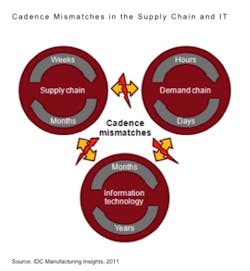Re-shoring and The Cloud: Two Supply Chain Strategies
Oct. 20, 2011
3 min read
At the control level, operations and engineering management have long dealt with the disconnect between how time is measured in plant floor operations compared with the measurement of time in the enterprise overall. On the plant floor, engineers tend to think in small segments of time — hours, minutes and seconds, even down to microseconds. At the corporate level, time is looked at more from a days, weeks, and months perspective. For IT, the concept of time tends to fall in the months and years category given the scope, complexity and cost typically associated with IT projects. Driving all three of theses areas is customer demand. Expectations here tend to reside in a framework of hours and days.
Addressing these perception and expectation differences has long been an issue for manufacturers that is continually being exacerbated by the increasing speed of the business cycle driven by the ubiquity of connection technologies.
In manufacturers' efforts to better align manufacturing/production operations with customer expectations, two trends seem to be emerging. One of these trends surrounds geographic and human resource factors and the other is technology driven.
A new report from IDC Manufacturing Insights, titled "Perspective: Clock-Speed Mismatches in the Modern Supply Chain" (#MI230556) tackles this issue of how "different parts of the supply chain operate with different cadences, or at different inherent clock speeds" and how manufacturers can and are addressing those differences.
Aligning with the nascent trend of re-shoring manufacturing operations to the U.S. in the face of increasing labor, transportation and time costs associated with products produced in far-away countries, the IDC report references the concept of "profitable proximity sourcing." In essence, this concept focuses on why companies should design and implement their supply networks based on a combination of cost, lead time and the location of demand.
"In some ways, it heralds a return to the 'make it where you sell it' principle of supply network design," says the author of the report, Simon Ellis, leader of the supply chain strategies practice area at IDC Manufacturing Insights.
This supply chain strategy is most useful, says Ellis, for products that "have a 'fashion' element to them," which ensures that the demand clock speed for those products remains high.
The technology trend increasingly being considered to address the manufacturer/customer clock speed disconnect is the much-hyped "cloud computing" concept. After all, the multi-year supply chain software rollout that has been the common approach used by manufacturers for the past 20 years doesn't always make the best sense in the face of customer demands that can change by the month or week.
Ellis notes in his report that, though manufacturer adoption of cloud technology is still low (about 22%), the cloud "offers a consumption model that is inherently more agile and flexible" and may be a sensible approach for manufacturers to increase "the speed with which capabilities can be made available to the supply chain."
For more information about Ellis' report, visit: http://www.idc-mi.com
About the Author
David Greenfield, editor in chief
Editor in Chief
David Greenfield joined Automation World in June 2011. Bringing a wealth of industry knowledge and media experience to his position, David’s contributions can be found in AW’s print and online editions and custom projects. Earlier in his career, David was Editorial Director of Design News at UBM Electronics, and prior to joining UBM, he was Editorial Director of Control Engineering at Reed Business Information, where he also worked on Manufacturing Business Technology as Publisher.
Sign up for our eNewsletters
Get the latest news and updates

Leaders relevant to this article:
